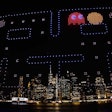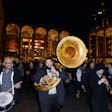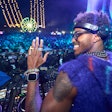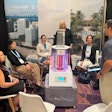
The Recording Academy announced last March that the Grammy awards, which hit the Staples Center last night, would fall on the awards’ earliest date ever and would mark the first appearance in January in their more than 50-year history. The 52nd annual awards, overseen by Recording Academy vice president of production and process management Branden Chapman, aired live on CBS—and garnered the highest ratings for the show in six years. Although some suggested the awards' earlier eligibility period could make the show appear dated, that might not have been an issue after last night's high-energy, performance-packed program.
Among the attention-grabbing acts was a tribute to Michael Jackson. Celine Dion, Jennifer Hudson, Smokey Robinson, Carrie Underwood, and Usher performed as part of the homage, in which guests donned cardboard glasses to view the 3-D video for "Earth Song," shown in This Is It. When the pop star's children, Prince and Paris, accepted a lifetime achievement award in his honor, the packed crowd inside Staples stayed utterly—and atypically—silent.
In a topical segment, nine-time winner Mary J. Blige and tenor Andrea Bocelli performed live together in a fund-raising effort for Haiti relief. The two performed a version of Simon & Garfunkel’s "Bridge Over Troubled Water," available for download online after the telecast, with all proceeds going to the American Red Cross to aid Haiti.
Among the additional performers were all five album of the year nominees—Beyoncé, the Black Eyed Peas, Lady Gaga (who performed the opening number with Elton John), the Dave Matthews Band, and Taylor Swift—with Swift eventually taking the prize to end the three-and-a-half-hour long ceremony, broadcast in HDTV and 5.1 surround sound on CBS.
Lighting designer Bob Dickinson oversaw the show's big-scale lighting spectacle, which included ShowPro's versatubes as well as video that popped against a set made up of staggered vertical layers of video display, lighting, and hard set pieces. The versatubes worked as horizontal bands of imagery to break up the vertical layers.
John Cossette Productions and AEG Ehrlich Ventures for the Recording Academy produced the show. Ken Ehrlich and John Cossette were its executive producers and Louis J. Horvitz directed.



















